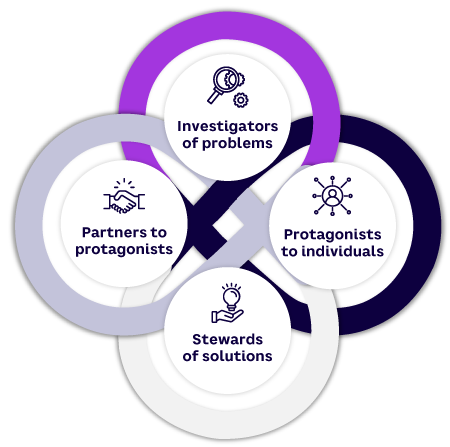AMPLIFY VOL. 37, NO. 9

Our society faces profound challenges that demand urgent collective action. Issues such as accelerating climate change, deepening inequality, and biodiversity loss are rooted in an anthropocentric economic paradigm. More than incremental changes are required: a systems-change approach is necessary to target the underlying causes and structural components embedded within societal, organizational, and ecological systems. Systems change involves transformative processes that reshape these infrastructures to achieve more equitable and sustainable outcomes.1
When pursuing systems change, problems are identified by many interactions, associations, and nonlinear dynamics.2 These interactions are based on a complex set of relationships between several stakeholders.
Purpose emerges from a dynamic interplay of personal experiences, values, beliefs, and aspirations.3 Rooted in core values and shaped by significant life experiences that provide direction and meaning, individual purpose is nurtured by relationships, community involvement, and the desire to contribute to something greater than oneself.
Purpose not only serves as a foundational principle, it can also energize systems change. In this article, we describe how a coalition of stakeholders successfully enacted purpose-driven systems change in the Global South.
The Symbiosis Project iteratively refined its founders’ purpose by cycling between their roles as investigators of problems and stewards of solutions.4 It then scaffolded purpose for many stakeholders, by looping them from partners to protagonists and from protagonists to individuals (see Figure 1).

Investigators of Problems
The Symbiosis Project began with two technology entrepreneurs wishing to tackle one of the most pressing challenges in emerging economies: access to and quality of higher education.
After selling their IT business, Alessandro and Vera Goulart, partners in life and business and coauthors of this article, refocused on societal impact. Determined to enact significant changes in the education system, they pursued master’s degrees to thoroughly investigate the issue of limited access to higher education and the inadequacy of workforce skills in Brazil.
The Goularts came to understand that Brazil’s higher education system was highly exclusive: it favored students who had received high-quality elementary education, which was usually provided by private institutions. Generally, higher education institutions failed to offer opportunities to vulnerable students, reducing the number of qualified professionals. At the same time, IT companies frequently complained about the gap between the technical skills being taught by higher education institutions and the practical skills needed in the business world.5 Post-hire, many companies complained about employees’ lack of social and emotional skills, which they considered a major barrier to professional growth.
The Goularts realized that a lack of access to higher education, low-quality higher education, and low levels of social and emotional skills were interacting in complex ways that made each harder to solve. They understood that systems change was needed to simultaneously promote inclusion, align educational outcomes with market demands, and cultivate adaptive, socially conscious professionals.
Alessandro explained that changing the system required much more than simply teaching technology. As investigators of the problem, the Goularts framed their purpose as preparing young people to use their talent and acquired technical skills to conquer their dreams without giving up their ethical values or a desire to contribute to society.
Stewards of Solutions
In 2017, the Goularts founded an innovative higher education institution in São Paulo, Brazil, called SPTech. They focused on a crucial aspect of academic training: ensuring that students were ready to apply their knowledge in real-world work environments.
Recognizing that supporting students in their transition to the job market was key to providing access to higher education, SPTech partnered with businesses that would co-create the curriculum and offer internship placements for all students entering their second term. Alessandro pointed out that “involving other stakeholders from the beginning was crucial, as it fostered ownership and ensured that diverse perspectives were considered.”
From the start, the Symbiosis Project aimed to create an environment that stimulated practice-oriented learning. Several IT companies that were keenly interested in enhancing the skills of professionals in the area committed to partner with the project. Starting in their second year, students would be hired by partner companies, allowing them to learn on the job while paying for their education.
Each company committed to supporting a specific number of students. The first year was financed by SPTech for all students, to ensure access to higher education. After that, partner companies would pay the students directly. By ensuring employment and fair remuneration for all students beginning with an internship at the end of the first year, they empowered the students to invest in their education.
SPTech’s high-quality education program changed the system by providing accessible higher education aligned with market demands, preparing students for careers in the tech industry, and offering pathways into employment.
To address the issue of students’ lack of socio-emotional skills, SPTech created a comprehensive socio-emotional education and character-training program focused on reflection, self-awareness, and personal growth. Vera, a scholar of character leadership and organizational psychology, created the curriculum. Using coaching, journaling, immersive experiences, and other approaches, SPTech helps students achieve a social and emotional maturity level that distinguishes them from other technology professionals entering the job market.
Thanks to a close relationship with students and a deep understanding of their skills and personality traits, the socio-emotional faculty team can successfully match students with partner companies. This gradual screening process ensures an optimal fit between the student and the company, minimizing mismatches with the company’s culture, expectations, and characteristics.
Coauthor Rafael Petry, another member of the Symbiosis Project, played a vital role by codesigning practice-oriented projects with future employers. Bringing IT companies’ real-world challenges and successes into the SPTech classroom reinforced their commitment to hire some of the graduates they were helping prepare for the job market. It also ensured that SPTech’s curriculum addressed the complex reality of professional qualification in Brazil.
The school’s physical space was designed to support the objectives of the Symbiosis Project. Its modern building sits on Paulista Avenue, São Paulo’s main economic hub. Three floors are dedicated to digital ecosystem companies (digital marketing, digital certification, identity recognition companies, vehicle-tracking companies, and gamification for training companies). There are also three labs (the Internet of Things, user experience, and design thinking) in partnership with some of the major companies in the digital market.
Partners to Protagonists
The Symbiosis Project launched with four partner companies and 60 students. Over the next six years, the number of partner companies expanded to 48, including IBM, HP, Google, Motorola, PwC, Deloitte, C6 Bank, Accenture, Tivit, Stefanini, inventCloud, and V8.Tech. The ecosystem now includes 150 technology professionals and an incubator. By 2023, the school had graduated its 1,000th student and had a 100% employment rate for graduates.
Protagonists to Individuals
The self-financing mechanisms built into the Symbiosis Project promote student autonomy. Many align their aspirations with SPTech’s purpose. The resulting sense of belonging and responsibility motivates students to adopt and personalize the collective purpose in ways that drive their decisions and actions, not only before they graduate but also after, as their careers progress. The collective purpose becomes a foundation on which individuals can begin building their own purpose.
Impact
The Symbiosis Project continues to create pathways to higher education, promote personal growth, and transform lives. Its ecosystem strengthens workforce qualifications to align with market needs, supports technological advancement, boosts the country’s economic potential, and helps reduce poverty and inequality.
Thanks in part to the Symbiosis Project, the school’s dropout rate decreased from 53% (2017) to 3% (2024). Enrollment increased at a rate of 159% between 2018 and 2024. After 2020, the cost of sponsoring a student was reduced by more than 90%, and after six years of implementation, the share of SPTech interns tripled in most of the leading Brazilian IT companies.
The project has significantly impacted several United Nations Sustainable Development Goals (UN SDGs), including SDG 4 (Quality Education), SDG 8 (Decent Work and Economic Growth), SDG 9 (Industry, Innovation, and Infrastructure), SDG 10 (Reduced Inequalities), SDG 1 (No Poverty), and especially SDG 17 (Partnerships for the Goals).
Guidelines
What can the Symbiosis Project teach us about purpose-driven systems change? Purpose is not enough. Systems changers must begin with an in-depth examination of why the old system persists. This investigation is not trivial, as many problems interlock. Solutions can be found, but better ones emerge when multiple stakeholders come together to share the same purpose. Purpose is not enough to keep going, either. A complex array of stakeholders must co-create visions and change models, commit to changing the system, and carry purpose forward in their broader networks and throughout their careers.
The following four guidelines are designed to ensure that purpose drives system-level change:
-
Critique the old. An in-depth examination of the issue’s root causes lays the groundwork for a collaborative approach. This inquiry exposes the systemic nature of the issue and emphasizes the need for a concerted effort to resolve it.
-
Co-create the new. Find stakeholders who are not just impacted by the problem’s root causes but also have complementary abilities, resources, or viewpoints. All parties are called to co-design solutions. Empowering stakeholder co-creation guarantees that the solutions will be adaptive and flexible enough to adjust to changing conditions.
-
Engage long term. All parties must continue to relate to the shared vision while meeting their own objectives. Putting in place procedures that promote continuing commitment, communication, and teamwork guarantees that participants remain engaged.
-
Track changes. Provide mechanisms for continuous assessment and observation. By monitoring results, stakeholders can control their progress, evaluate the results of their interventions, and make needed corrections. Continuous observation ensures that the relationship stays in balance and that the system adapts to new opportunities or obstacles.
Conclusion
The Symbiosis Project demonstrates how individual purpose can evolve into collective purpose, driving critical interventions for systems change. It also shows how collective purpose can resonate with individuals in the system, helping them develop and reinforce their own sense of purpose.
The Symbiosis Project followed guidelines for purpose-driven change, resulting in codevelopment of cutting-edge technical content, implementation of social-emotional skills-development programs, the fostering of practice-oriented transformative learning, and an ability to change students’ futures by successfully preparing them for the job market.
References
1 Waddock, Sandra, et al. “The Complexity of Wicked Problems in Large Scale Change.” Journal of Organizational Change Management, Vol. 28, No. 6, October 2015.
2 Pongeluppe, Leandro S. “The Favela Effect: Spatial Inequalities and Firm Strategies in Disadvantaged Urban Communities.” Strategic Management Journal, Vol. 43, No. 13, May 2022.
3 Lashitew, Addisu A., Oana Branzei, and Rob van Tulder. “Community Inclusion Under Systemic Inequality: How For-Profit Businesses Pursue Social Purpose.” Journal of Management Studies, Vol. 61, No. 1, January 2023.
4 The term “symbiosis” comes from biology and defines close, long-term interaction between two or more organisms, which can take various forms. These interactions are crucial for ecological balance and species evolution.
5 Van Roy, Vincent, Daniel Vértesy, and Marco Vivarelli. “Technology and Employment: Mass Unemployment or Job Creation? Empirical Evidence from European Patenting Firms.” Research Policy, Vol. 47, No. 9, November 2018.







